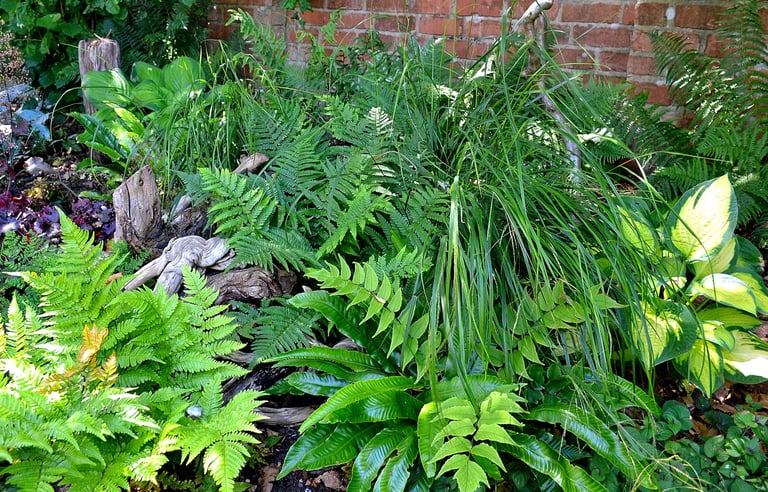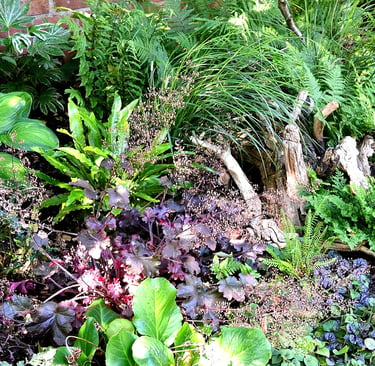Re-vamping an overgrown and shady corner
How to enliven a tired overgrown and neglected area with some shade loving plants and a bit of a stumpery!


30+ years ago this part of the garden was planted with various easy to care for shrubs. Since then, the surrounding trees have matured making the area quite shady. The original shrubs were a bit run of the mill and un-exciting, not to mention that the more vigorous ones had become overgrown and were dominating the space.
The area needed re-vamping.
It was decided that most of the shrubs have to go – with the exception of the Mahonia × media at the top end, which has become quite architectural, and the Corylus avellana 'Contorta' [Corkscrew hazel] at the other which provides winter interest. Also these two book-end the area and make it more contained.
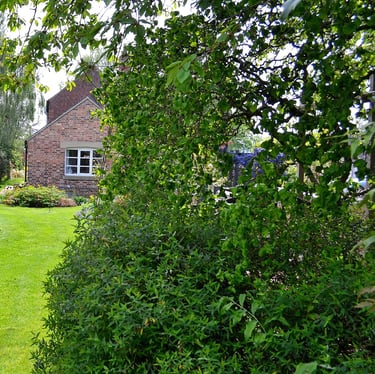

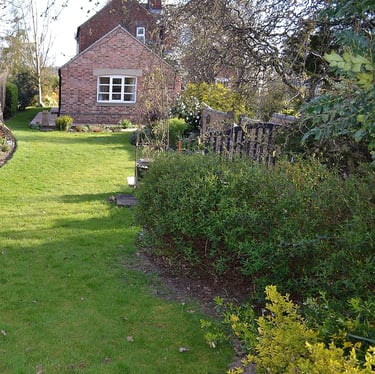

Some hours later, after a workout with mattock, spade and fork and the area is more or less cleared.


It now needed forking through and raking over to remove as many of the smaller roots as possible (not to mention the rusty bolts, broken glass and bits of brick).



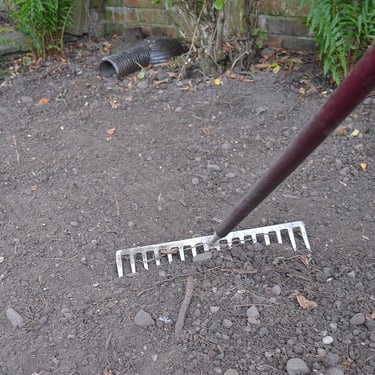
After years of neglect the the light soil has become impoverished and lacking in body so we needed to add as much organic matter, in the form of garden compost and bagged manure, as we could lay our hands on. We aimed for a depth of 7 to 8cm (3"). This was lightly forked into the top layer of soil.
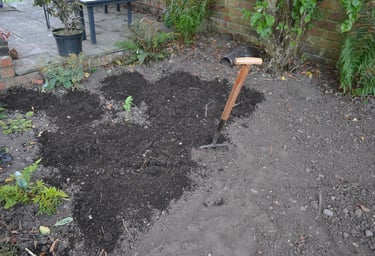

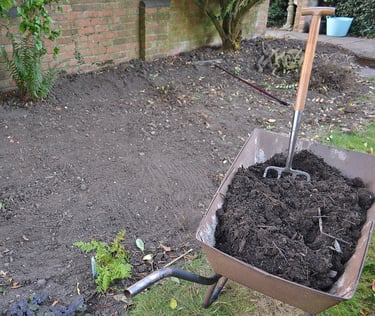

The edge between the bed and the lawn had become ill defined due to it being covered by the overhanging shrubs.
The desired shape was laid out with a hose pipe. You could also use rope but this tends to be more floppy and is harder to make a nice sweeping curve.
Work along the line of the pipe with a spade to create a nice clean edge.
Call me old-fashioned but I prefer an edge, as its easier to keep a crisp outline with edging sheers later on. It also helps stop the lawn grass spreading into the adjacent bed.
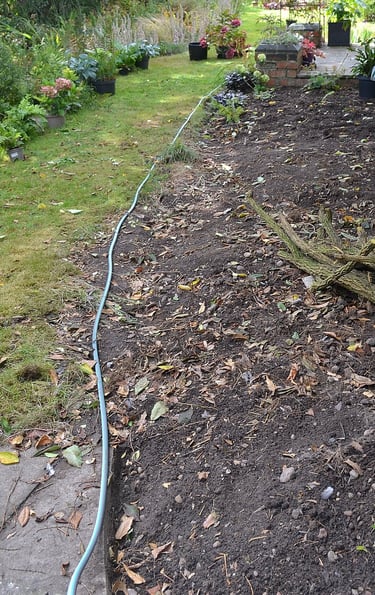

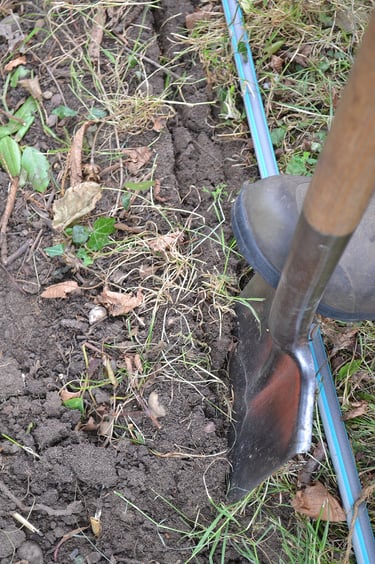

Next the stumpery was created from bits of wood that had been lying around. Old tree stumps, roots, pruned tree boughs, bits of twisted Wisteria stem that refused to flower, in fact anything really if it has an attractive shape or texture. Hopefully it will create some interest amongst the planting.
Another benefit of a stumpery is that they provide habitat for some of the smaller critters.
If there are pockets or cervices in-between the pieces, these can be planted with small plants.
It might not be on the scale of the stumperys at Biddulph Grange or Highgrove House but we have to start somewhere...




Don't just charge ahead and start planting, lay the planting area out by placing the plants, still in their pots, where you think they should go, view the area from all around and see how everything looks. Move plants around until you have effect what you want.
When planting a shady area we are considering amongst other things, plant shape, leaf colour and texture.
Another consideration is size that the plants may become, If something is going to get quite large quickly then you can give it room, if it is slow growing then plants can be more closely spaced around it. You can always move the smaller ones around when they become too congested.
Planting list
Bugle Ajuga reptans
Lady's mantle Alchemilla mollis
Cows parsley Anthriscus sylvestris 'Ravenswing'
East Indian holly fern Arachniodes aristata 'Variegata'
Harts-tongue fern Asplenium scolopendrium
False goats beard Astilbe 'Brautschleier' (× arendsii)
Greater masterwort Astrantia major 'Star of Billion'
Elephant’s Ears Bergenia cordifolia ‘Shoeshine Rose’
Hard fern /Deer fern Blechnum spicant
Fortune's cyrtomium Cyrtomium fortunei
Foxgloves Digitalis purpurea 'Dalmatian White'
Dryopteris austriaca 'Lepidota Crispa Cristata'
Champion's wood fern Dryopteris championii
Kidney fern Dryopteris cognata
Copper shield fern Dryopteris erythrosora
Autumn Fern Dryopteris erythrosora 'Briliance'
Male fern Dryopteris filix-mas
Plantain lily Hosta (varous)
Japanese spurge Pachysandra terminalis
Braun's holly fern Polystichum braunii
Japanese lace fern Polystichum polyblepharum 'Jade'
Soft shield fern Polystichum setiferum
Korean rock fern Polystichum tsus-simense
Labrador violet Viola labradorica


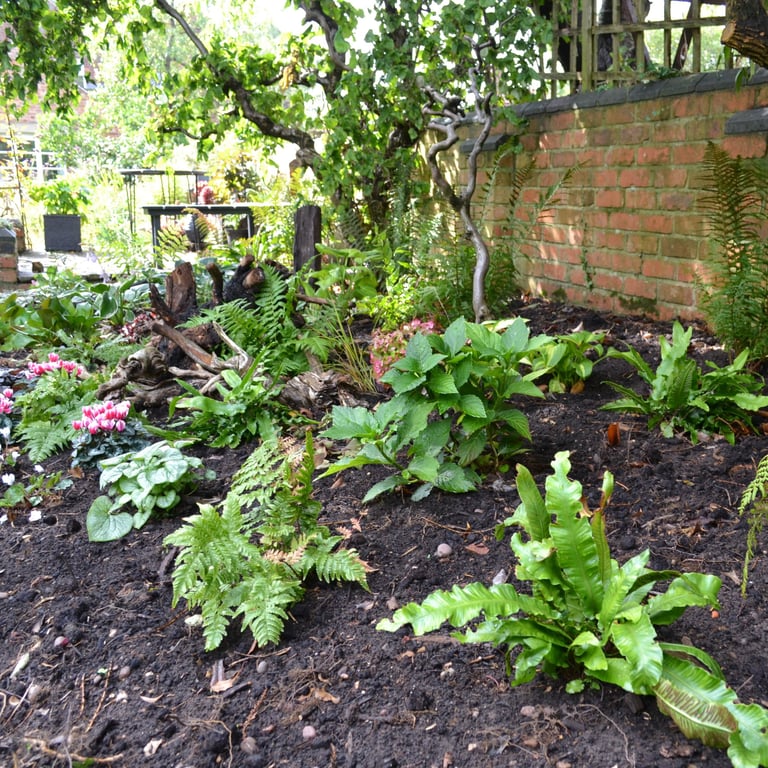

The end result.
This is what it looks like coming up to one year later. Everything has filled out nicely.
One or two of plants have succumbed to the dry spring and hot dry early summer and look a bit stressed (one or two ferns and a couple of the Asplenium scolopendrium) however almost all are flourishing.
Update - 10 months later...
